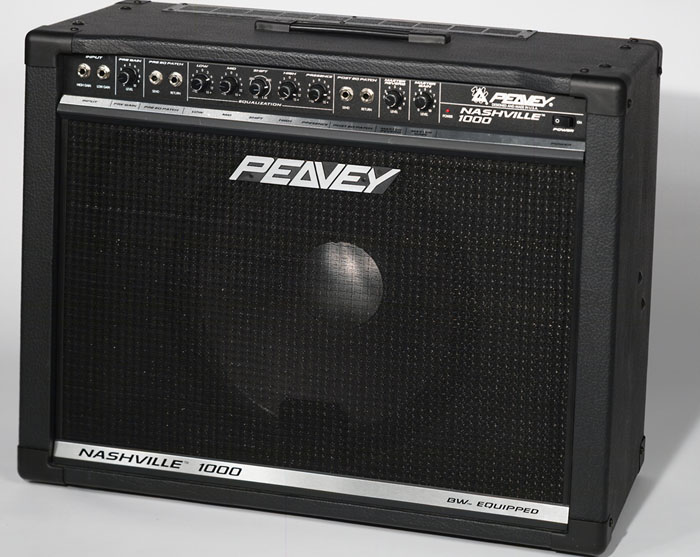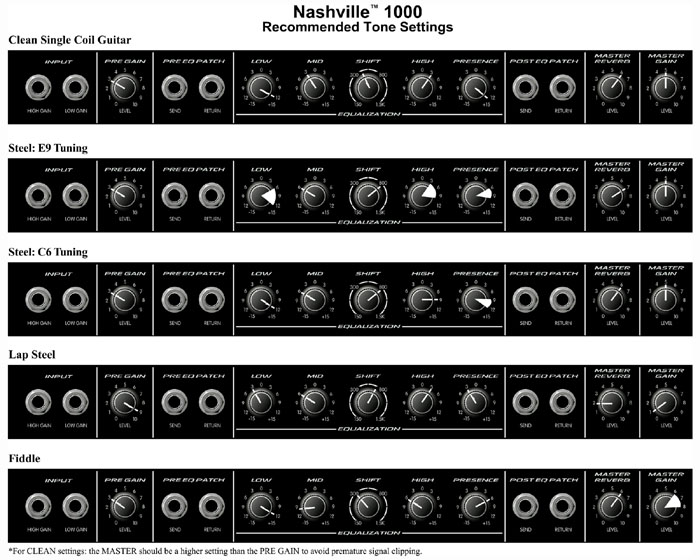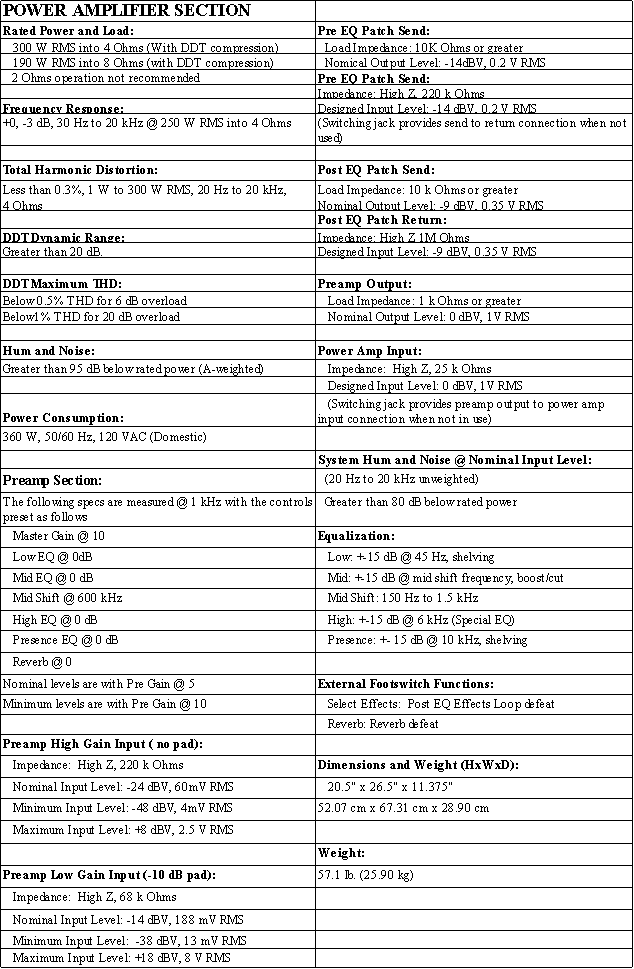| Danny Hullihen | home |
| Nashville 1000 | Greer Cases |
| Nashville 1000 |
Product Review of
PEAVEY’s NEW
NASHVILLE 1000
By Danny Hullihen
One of the latest additions to the Steel Guitar amplifier line is the Peavey Nashville 1000

The new Nashville 1000 is rated at 300 Watts via a Digital Power Amplifier (AKA Switchmode) which provides for a cleaner & faster response than the standard analog amplifier.
The Nashville 1000 comes equipped with Peavey’s 1501-SB (shallow basket) Black Widow Speaker, which can handle a lot of power. This speaker has been specially voiced for Steel Guitar applications, and we’ve discovered that it also performs well for violin and jazz guitar applications. Originally, Peavey had plans to use a Neodymium Magnet which would have resulted in being a bit lighter than Alnico type Magnets, and would have provided an additional 3Db. of gain. Unfortunately, Neodymium (a rare earth material) is very expensive to manufacture, and it wouldn’t have been cost efficient given the benefit to $ comparison. In the best interest of the player, Peavey ultimately opted for the 1501-SB instead, which is a time proven design, and has been the industry standard for many years in steel guitar amplification.
Although the Black Widow 1501 is indeed capable of handling a great deal of power, I feel that I should caution those who are using this amp that the awesome power of the Nashville 1000 is capable of driving the speaker out of its gap when played at maximum volume levels. This is not to say that the speaker isn’t capable, but moreover, the Nashville 1000 is an amplifier that is capable of delivering awesome power beyond any other combo-type amplifier ever built for steel guitar applications.
The Cabinet design of the Nashville 1000 is made of void-free plywood which provides for better tonal response throughout the entire spectrum of the Steel Guitar, Violin and Jazz Guitar range. In comparison, most other amplifier cabinets were made of particle board material. Although durable, particle board produces more of a “boxy sound” compared to the tone spectrum capabilities of a void-free plywood cabinet. As many have now discovered, the Nashville 1000 is different than any other amplifier in its class. Whatever kind of tone you’re looking for, the Nashville 1000 is capable of producing it. Whether you want to peel wall paper with screaming highs, break glass with thundering lows, or play at low volumes, the Nashville 1000 will produce the sound you want at any level.
Another Unique feature of the Nashville 1000 is the screwed-in Baffle, as opposed to the glued-in baffles used in their previous amps. In many test of comparison, Peavey discovered that this configuration gives better tonal characteristics overall, and a bigger low end response.
With regards to Weight, the Nashville 1000 weighs in at 57 Lbs., which is @ 10 Lbs. lighter than the Nashville 400. Although this may not be an extreme reduction, this does make a big difference to a lot of guys.


The Front and Back of the Amp
There are 2 input channels on the Nashville 1000. This was done to accommodate the many different kinds of Steel Guitar Pickups being offered on the market today. The High Gain input is primarily for passive type Pickups and/or factory installed single coil Pickups. The Low Gain input is designed for active Pickups, or hot pickups such as the Bill Lawrence L-710 Series Pickups. This is not to say that these inputs cannot be used vice-versa, but the option is there for you to experiment with either way. No matter what your pickup of choice might be, you’ll discover that the Nashville 1000 was designed to accommodate just about anything you feed it with.
Peavey has also incorporated the Pre EQ Patch on this amp, which is basically used for patching the volume pedal in. Although not many use this feature, it is the recommended way for patching your volume pedal, and makes for a more responsive guitar - amplifier signal.
The Nashville 1000 has been designed with a highly responsive Active EQ Circuit, very much like that used in some previous Peavey Steel Guitar amplifiers, such as the Nashville 400 & the Session 500. Typically, when the EQ controls are set at 0, they have no affect on the sound.
For those who would like more specific details, Mike Brown of Peavey Electronics, and Jeff Newman of Jeffran Music have produced a video covering all the features of the Nashville 1000, as well as the soon to be released, Session 2000. This video was produced for the novice as well as the pro, and there is something in there for everybody with regards to setting up the new Nashville and Session 2000 amplifiers. You can obtain this video direct from Jeffran College by calling 1 (800) 373-3418. Or you can write to Jeff at: Jeff Newman - 5320 Poplar Hill Road - Watertown, TN. 37184. The video sells for $15.00, plus Shipping and Handling.
Also included in the new Nashville 1000 are the Post EQ Patch points for connecting Effects Units, such as the Profex, Tubefex, Transtubefex, or stomp boxes.
With the all new design of the Nashville 1000 there is absolutely no need for after-market circuitry modifications. This isn’t to say that modifications were needed on previous amplifiers, however, for those of you who believed it was a necessity, (however arguable that may be,) this modification is designed into the circuitry of this amp.
The back of the Nashville 1000 has 3 1/4” jacks. The remote switch jack is for plugging in a two button foot switch (included) that controls the Spring Reverb, and for turning on or off the Effects Loop. The Power Amp in jack was designed for plugging in Effects Units in cases where you’d prefer to bypass the EQ section of the amplifier, so you could use the EQ settings from your Effects processor. Plugging into this jack makes the amp work like a slave unit, using only the Power amp and Speaker, bypassing the amps E.Q. section.
The Pre Amp out jack is an output from the Pre Amp only.
The Line Out Jack, which is an XLR type, is made for going direct out the amp to a mixing console &/or direct to tape, as with concert performances, or studio applications.

For those of you who already have the new Nashville 1000, here’s a few settings you might want to experiment with that were used by some of the pros during the May ‘99 Jam session in Nashville, Tennessee. The Nashville 1000 was being used exclusively at this show.
Paul Franklin - Amp #1 - Low +9, Mid -6, Shift 500Hz., High +3, Presence -3.
Amp #2 - Low +6, Mid -9, Shift 500Hz., High 0, Presence +3.
Lloyd Green - Low +6, Mid -10, Shift 600Hz., High +3, Presence +6
Johnny Cox - Low +9, Mid -10, Shift 800Hz., High +3, Presence -3
Stu Basore - Low -6, Mid -5, Shift 750Hz., High -6, Presence +3
Randy Beavers - Low +9, Mid -5, Shift 800 Hz., High +6, Presence +6
Hal Rugg - Low +6, Mid -6, Shift 700 Hz., High +2, Presence -3
For those of you interested in the Nashville 1000 Specifications:
